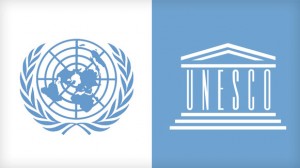Trump Tariffs on Russia’s Oil Buyers Bring Economic, Political Risks
From punishing Brazil to trying to curb imports of fentanyl, U.S. President Donald Trump has wielded the threat of tariffs as an all-purpose foreign policy weapon.

 United Nations agencies in Paris yesterday launched a plan to improve the management of oceans and coastal areas. The Blueprint for Ocean and Coastal Sustainability sounds the alarm about the health of the oceans and recalls that, although the ocean accounts for 70 per cent of the surface of our planet, only one percent of it is protected.
United Nations agencies in Paris yesterday launched a plan to improve the management of oceans and coastal areas. The Blueprint for Ocean and Coastal Sustainability sounds the alarm about the health of the oceans and recalls that, although the ocean accounts for 70 per cent of the surface of our planet, only one percent of it is protected.
Presented at UNESCO, the Blueprint was prepared for consideration by the UN conference on sustainable development and proposes a series of concrete measures to:
• Create a global blue carbon market as a means of creating direct economic gain through habitat protection
• Fill governance gaps in the high seas, by reinforcing the United Nations Convention on the Law of the Sea (UNCLOS)
• Support the development of green economies in small island developing states
• Promote research on ocean acidification- how to adapt to it and mitigate it.
• Increase institutional capacity for scientific monitoring of oceans and coastal areas
• Reform and reinforce regional ocean management organisations
• Promote responsible fisheries and aquaculture in a green economy
• Strengthen legal frameworks to address aquatic invasive species
• “Green” the nutrient economy (fertilizers for example) to reduce ocean hypoxia and promote food security
• Enhance coordination, coherence and effectiveness of the UN system on ocean issues.
The blueprint emphasizes that 60 percent of the world’s major marine ecosystems have been degraded or are being used unsustainably, resulting in huge economic and social losses. Mangrove forests have lost 30 to 50 percent of their original cover while coral reefs have lost 20 percent, increasing the vulnerability of many highly populated coastal areas. The ocean absorbs close to 26 percent of atmospheric carbon dioxide emissions which is provoking acidification that is already threatening some varieties of plankton and poses a threat to the entire marine food chain and dependent socio-economic activities.
Some of these phenomena are aggravated by cumulative pressures such as climate change, intensified human activity and technological advances. Furthermore, ecosystems situated in the deep ocean, where biodiversity and habitats often have major value, but are generally not well understood, have virtually no protection at all.
The international community pledged to tackle these challenges at the Summits of Rio (1992) and Johannesburg (2002), however, the commitments made then remain largely ineffectual and their objectives have not been met. A case in point is the pledge to restore fish stocks to sustainable levels by 2015 and the promise to create networks of protected marine areas by 2012. Few countries have adopted legislation to reduce land-based marine pollution, leading to an increase in the number of dead ocean areas. More than 400 marine areas have been listed as “biologically dead” to date.
“The full implementation of many of these goals and targets will require further efforts by States, intergovernmental organizations and the international community,” state the authors of the report. They claim the present situation is the result of insufficient political will and resources, inadequate institutional capacities, insufficient scientific data and market imbalances.
“Greening the Blue Economy will be science and technology driven,” they conclude. “But success will depend on sound policy processes and effective institutional arrangements and will therefore require commitment and funding from the international community as well as nations and industry.”
The Blueprint was prepared by UNESCO’s Intergovernmental Oceanographic Commission (IOC), the United Nations Development Programme (UNDP), the International Maritime Organization (IMO) and the UN Food and Agriculture Organization (FAO).

Sign up for gCaptain’s newsletter and never miss an update

Subscribe to gCaptain Daily and stay informed with the latest global maritime and offshore news
Essential news coupled with the finest maritime content sourced from across the globe.
Sign Up